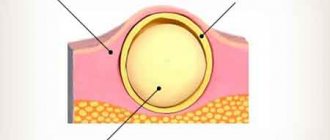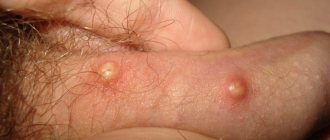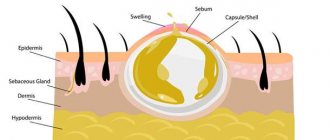Atheroma of the scrotum and penis: photos, symptoms and treatment of atheromatosis
A benign neoplasm in the genital area that develops as a result of blockage of the sebaceous glands is called atheroma of the scrotum.
In appearance, the tumor resembles a small rounded tubercle, which causes significant discomfort to the patient due to its location. For men, multiple atheromas typically appear, which tend to open on their own.
Let's consider the symptoms of a pathological neoplasm, and how to cure it with medications?
What is atheroma of the scrotum?
Atheroma on the scrotum appears to be a fairly common pathology. The formation is localized in places where there are sebaceous glands and hair follicles. Cystic neoplasm belongs to the group of benign tumors.
Sebaceous gland cysts are a typical consequence of the accumulation of fatty secretions, since there is a blockage of the excretory canal. Atheromatosis does not pose a particular danger to men's health, however, the appearance of wen on the penis, testicles and scrotum leads to discomfort and pain.
For information, atheroma on the penis or scrotum is not a hollow, but a filled capsule containing a thick secretory fluid.
According to static information, atheroma in representatives of the stronger sex is diagnosed at any age. Sometimes multiple clusters of pathological neoplasms develop in patients.
If they are small in size, they open on their own.
But at the same time, long-term recurrence is also noted - in place of one opened atheroma, after a certain period of time, a new one appears.
Atheroma in the genital area can be observed more often in men than in the fair sex. This is due to the concentration of the hormone testosterone, which is a priori higher in men.
If you have atheromatosis of the scrotum or penis, you should visit a medical specialist. The pathology is treated by a dermatovenerologist or urologist. As a rule, the diagnosis is made based on visual examination of the tumor. It is rarely necessary to differentiate atheroma from other diseases. If a man has an inflammatory process, then additional diagnostic methods will be required.
Characteristics of the neoplasm
Impaired functionality of the sebaceous gland in the groin area is characterized by the fact that it provokes the development of a neoplasm, which has a dense consistency to the touch. This “ball” is characterized by mobility and clear boundaries.
The peculiarity of the manifestation is that at the site of localization of the atheroma, the skin does not gather into a fold. The rounded “ball” located under the skin is small in size. As a rule, it is about one centimeter in diameter, extremely rarely it grows up to one and a half centimeters.
Important: upon palpation, the cystic formation may move several centimeters, and mild painful sensations are noted.
Separately, secondary atheromas on the penis or scrotum are distinguished. They are diagnosed in patients who have a history of seborrhea, increased sweating and some other pathological conditions.
Distinctive features of secondary atheroma:
- The neoplasm is blue in color and very dense to the touch;
- Pain is felt upon palpation.
Any atheroma has contents that are located in the capsule. When multiple cysts are present in the groin area, they speak of the disease atheromatosis. The etiology differs significantly.
The primary reason is an increase in testosterone production. Increased sweating and excessive activity of the sebaceous glands in the body are identified as provoking factors.
Penile atheroma is a benign neoplasm. Only in exceptional cases can it transform into a malignant tumor. No more than ten cases have been described in medical practice.
Clinical manifestations and symptoms
At the initial stage of atheroma development, there are no symptoms. Perhaps, no signs are observed while the cystic formation is small - up to five millimeters in diameter.
As a man grows, he discovers a rounded “ball” under the skin. Sometimes pain or discomfort occurs during palpation. With a low pain threshold, subjective sensations are completely absent.
If there is no inflammatory process, then the skin at the site of compaction has a normal shade. In a situation where there is inflammation, the following clinical manifestations are observed:
- Redness of the skin around the formation;
- Pain and discomfort due to lack of palpation.
In approximately 20-30% of clinical presentations, patients complain of itching sensations. Itching is not a characteristic sign of atheroma, so such manifestations can be attributed to other abnormal processes.
If the atheroma of the scrotum has purulent contents and the capsule has opened, but the contents do not come out, then the entire groin area and reproductive organ turn red, and severe pain is present. This indicates that an infectious process has joined the neoplasm.
If the wen is small, it can open on its own. In this case, the contents and the capsule itself come out. There is a certain risk of relapse when a new one forms on the penis or scrotum in place of a previous formation.
In the presence of an infectious process, general health worsens. The symptoms are as follows:
- Severe pain in the area where the atheroma is located.
- Swelling of the penis, scrotum.
- Hyperemia of the genital organs.
- Weakness and lethargy.
- Increase in body temperature.
- General malaise.
When such signs are detected, you should immediately seek medical help, as there is a high probability of developing an abscess.
Treatment of atheromas with medications
Penile atheroma is not a condition that threatens the health and life of patients. If the neoplasm does not hurt, is not inflamed and has not reached a huge size, they prefer not to touch it.
It is worth knowing: in most cases, atheroma is removed surgically - a small incision is made, through which the capsule with the contents is removed. For small tumors, conservative therapy is used.
Conservative treatment involves the use of medications that are used internally and externally. For oral administration, it is recommended to take antibacterial drugs belonging to the pharmacological group fluoroquinolones.
The effect of application is as follows:
- The immediate cause of blockage of the sebaceous glands is eliminated;
- Inflammation goes away;
- The purulent contents are destroyed.
For topical use, Vishnevsky ointment may be prescribed. The medication contains birch tar, a combination of bismuth, silicon dioxide and castor oil. The natural medicine helps draw out the pathological contents through the ducts of the sebaceous glands.
Since Vishnevsky ointment is characterized by an anti-inflammatory and antimicrobial effect, the drug helps reduce the severity of the inflammatory process and destroy pathogenic microorganisms.
Method of using Vishnevsky ointment for the treatment of atheroma:
- Take a piece of bandage or gauze and fold it into several layers according to the size of the tumor.
- Apply a topical solution to a cloth and apply it to the cyst.
- From above, everything is fixed with a clean bandage and secured with a plaster.
- The dressing should be changed 3-4 times a day.
Reviews note that the result is observed within a couple of days. However, you should not stop treatment, since you need to draw out the entire contents of the capsule.
Fact: Vishnevsky ointment helps draw out the contents, but does not help pull the capsule out, so relapse of the disease cannot be ruled out.
Preventive actions
You can prevent the formation of a cyst if you follow basic hygiene rules - take a shower in the morning and evening, and regularly clean the external genitalia. To do this, use warm or hot water with soap or gel.
To cleanse the pores of the skin from fatty inclusions, steam baths are required - they help prevent the development of atheroma on the scrotum or penis. Also in prevention, a man’s nutrition is of no small importance. Blockage of the sebaceous glands in most clinical pictures is a consequence of excessive consumption of animal fats.
It is advisable to support immunity. To do this, take vitamin and mineral complexes in courses. To prevent sweating in the groin area, you should dress correctly - avoid skinny jeans and underwear made from non-natural materials.
You should not squeeze out the contents of the cystic formation with your hands - there is a high probability of infection. In this case, long-term treatment will be required.
Atheroma on the scrotum is a common phenomenon in men. Being small in size, it does not pose a health hazard. If the formation grows, becomes inflamed and festers, you should immediately consult a doctor.
Source: https://ManExpert.ru/andrologiya/zabolevaniya-polovyh-organov/ateroma-moshonki.html
Diagnosis of the disease
If the cause of blockage of the sebaceous glands is not a violation of personal hygiene or injury, then the patient is referred for examination. To identify the causes of the appearance of omentum on the penis, a man must undergo the following types of tests:
- Complete blood test for hormones;
- Urine for protein content;
- Secretion from the omentum to check for infection.
A detailed blood test will help determine whether a man has any hormonal changes. If the level of testosterone or estradiol is elevated, the patient is prescribed hormonal treatment.
Urine for protein is taken to identify the presence of an inflammatory process in the body. If the level of protein in the urine is elevated, then the patient experiences inflammation. Next, the doctor needs to find out what disease caused the blockage of the sebaceous glands.
Secretion from the sebaceous gland is necessary to detect infection. In laboratory conditions, the secretion is inoculated into a special cup. After one week, a specialist examines the overgrown colonies of bacteria. The sensitivity of the bacterium to the effects of antibiotic therapy is being studied. The antibiotic that has shown the best effect is prescribed to treat the disease.
Atheroma of the scrotum and penis: photos, causes and removal
Atheromas of the penis and scrotum (wen, sebaceous gland cysts) are benign cystic formations that, in the absence of complications, do not cause harm to the body. They are formed under the influence of certain factors in every fifth representative of the stronger sex, mainly upon reaching the age of twenty.
Neoplasms that are small in size do not cause any trouble, but due to their specific location they greatly reduce self-esteem. But a complicated form of pathology can lead to serious health problems.
Therefore, if any formation occurs in the intimate area, you should visit a dermatovenereologist or urologist, who will determine treatment tactics.
Causes
Cysts of the penis or scrotum appear due to trauma to the genital organs or blockage of the sebaceous glands.
- Poor hygiene when shaving, using low-quality or dull razors.
As the blades become unusable, they microscopically damage the skin of the genital organs. In this place, ichor and plasma particles accumulate, which subsequently become infected. In this way, atheroma develops on the penis. Poor hygiene when shaving. - The most common cause of genital cysts is clogging of the sebaceous glands.
Excessive fat secretion leads to narrowing or complete blocking of the excretory duct. If hair growth is observed in this area, then the follicles are involved in the process. They rupture from excess fat accumulation, and a cavity or atheroma of the scrotum forms around the source of inflammation. Clogging of the sebaceous glands leads to the formation of atheroma.
Benign neoplasms of the external type sometimes appear during puberty, when there is an active release of sex hormones. And internal tumors of the urinary system naturally appear after a decrease in sexual activity and the development of congestive processes in the penis.
The risk of atheroma in the groin in men increases significantly if he wears tight underwear made from non-natural fabrics.
Excessive sweating occurs in this area. Gradually, minor depressions form in the groin or scrotal area, into which the product of the sebaceous glands enters. The greatest danger is posed by an infected cyst, where the active development of pathogenic microflora occurs.
Rehabilitation period
After surgery, the incision site requires careful care. Every day you need to bandage the wound, use antiseptics, anti-inflammatory ointments that prevent suppuration of the sutures and infection. If you do not adhere to the rules of rehabilitation, atheroma may appear again.
Important! After excision of the capsule, the first few days of dressing should be done twice a day. It is advisable that this process be handled by the attending physician.
When suturing, a special material is used, which subsequently dissolves. The scar in the groin heals in three months. When removing a wen on the chest or back, the wound heals a little faster.
Symptoms and possible localization
The manifestations of the tumor depend on what type of course it has and where it is localized.
- Atheroma of the scrotum. The patient exhibits round, elastic formations. There is no pain in 80%. The atheroma adheres to neighboring tissues, and a black dot is observed inside the formation. When suppuration occurs, the surface of the capsule turns red, becomes painful, and an infected secretion from dark green to brown can be released from the surface.
- Atheromas of the penis. A dense capsule appears on the shaft or head of the penis. It causes severe itching, but in the absence of infection it does not change color. During the inflammatory process, the skin bulges and its temperature rises. The penis swells and turns red. There is a high probability of self-opening of penile atheroma while wearing underwear.
The left or right testicle is deformed.
- Testicular cyst (right and left epididymis). At the early stage there are no signs, the capsule is no larger than a pea. It is difficult to determine the formation by palpation. As the tumor grows, pressure occurs on the seminal duct, and the left or right testicle becomes deformed. Pain and a feeling of squeezing appear in the abdominal area. During sexual intercourse, severe discomfort occurs.
How to distinguish from similar skin formations
The diagnosis of atheroma can be made during an objective examination of the patient. It is enough to collect complaints, anamnesis and compare them with specific symptoms of the disease. The final diagnosis can only be made by histological examination.
Differential diagnosis is carried out with the following diseases:
Source: https://gidroz.ru/onkologiya/ateroma-na-chlene.html
Places of distribution
Bubbles appear in the penis area in different places on the skin. The location of the formation will directly depend on its type. Large rashes are located at the very base of the genital organ. Small pimples - near the head of the penis. Sebaceous glands, which are common in the hair, can provoke an inflammatory process.
Condylomas usually form in the urethral area. After a certain period of time, the inflammatory process moves to the head. The resulting formations bring unpleasant sensations, which can be explained by the fact that the head contains a large number of nerve endings that provoke pain and send an impulse to the human brain.
What to do if there is a cyst on the penis
Cystic formation on the penis is a widespread phenomenon.
However, at the initial stage of pathology, people often do not seek help from a specialist, waiting for alarming symptoms indicating the development of an inflammatory process or suppuration.
A lump on the genitals is fraught with serious discomfort and dangerous complications, so it is important to know the provoking factors of the disease.
What is a cyst on the penis?
Atheroma is a benign neoplasm that occurs due to clogging of the sebaceous glands. In a similar scenario, whiteheads develop on the face. Lipoma can form in any part of the body where glands are present. Often a cyst is mistaken for a wart or papilloma, which is caused by HPV.
Most people are infected with the virus. The formation of dense defects on the genital organ occurs due to decreased immunity. Viral tumors are dangerous due to infection and malignant degeneration.
Minor cysts are asymptomatic and go away on their own. These lipomas often appear in middle age. The wen itself looks like a small pimple or polyp. Inside the capsule there is white or yellow content, consisting of accumulated stagnant secretion of the gland, epithelial and fat cells.
A penis cyst is not an infectious pathology that is not transmitted through sexual intercourse. In most cases, atheroma is not dangerous, but sometimes the wen becomes inflamed or filled with pus.
Causes
Lipoma on the genitals in men develops due to:
- Improper shaving of the intimate area, use of a razor. Such a blade often damages the delicate skin, which can also lead to infection.
- Failure to comply with personal hygiene rules, using someone else's toothbrush, towel, comb.
- Hormonal imbalance. Atheroma appears especially often in adolescents due to excessive testosterone production.
- Increased sweating in the groin area, resulting in blockage of the sweat and sebaceous glands.
Wen also occurs due to wearing tight trousers and tight underwear. Depilation and piercing often injure the sebaceous glands, which also provokes the appearance of pathology.
Clinical manifestations
Cysts less than one centimeter almost always do not cause discomfort. An increasing atheroma makes itself felt by a noticeable dense tubercle that does not cause pain upon palpation. In the absence of an inflammatory process, the skin over the defect is smooth.
If an infection has entered the wen, the patient begins to suffer from severe itching, mild pain, redness of the epithelium around the formation, and increased temperature of the affected area.
Lack of timely treatment leads to significant swelling of tissue structures, severe pain, and hyperemia. At the same time, pathogenic microorganisms also infect other organs of the reproductive system.
The process of suppuration is dangerous due to the formation of an abscess. If the lipoma progresses well, it can open on its own, releasing a capsule with its contents.
Diagnostics
A penile cyst is easily diagnosed, without the use of hardware and laboratory research methods. An experienced specialist is able to establish an accurate diagnosis even during an external examination of the affected organ.
- Editorial board of Oncology.ru
- May 27, 2020
In this case, the doctor is obliged to exclude diseases that are similar in symptoms, for example, Peyronie's disease with dense scars on the skin of the penis, lymphangitis with chronic inflammatory damage to the lymph nodes, smegmolitis with a pathological process in the head and foreskin due to deterioration of the outflow of secretions, allergic reactions, dermatological problem or benign sebaceous gland adenoma.
Lipoma can recur, so it is important to identify the true cause, the provoking factor for the development of the wen.
Treatment methods
Atheroma is a non-lethal disease that rarely worsens the general condition of the body. If the formations are small in size, there are no unpleasant sensations, or an inflammatory process, only periodic observation by a specialist is required without surgical intervention.
If redness appears and purulent contents begin to be released, the cyst should be removed immediately. In this case, elimination of the pathological formation does not require hospitalization. The gland duct is drained, followed by curettage of the capsule.
The classic operation is performed under local anesthesia. During standard surgery, the capsule is opened to allow free release of purulent contents. After this, the cavity is treated with an antiseptic solution, and the body of the cyst is removed.
- Editorial board of Oncology.ru
- February 25, 2020
The rehabilitation period consists of treating the wound with special ointments and antiseptics. Antibiotics are not prescribed in this case.
If the atheroma is not inflamed, but causes only cosmetic discomfort, then electrical destruction or radio wave method is used to eliminate the problem. These two modern methods of getting rid of a wen on the penis are indicated only for small lesions and are done under local anesthesia.
Possible complications
Self-treatment is contraindicated, because in rare cases a cyst leads to serious consequences, such as:
- Abscess.
- Phlegmon.
- Penetration of pathogenic microorganisms into the lipoma cavity.
- Infection of neighboring tissues.
- Repeated accumulation of purulent contents after its elimination at home.
- Penetration of pus into the tissue under the skin.
Some of the complications can cause significant harm to the sexual organ and the entire body, so you should not self-medicate.
Forecast
The prognosis for wen of the genital organ is very favorable. If the atheroma is small, not inflamed, and does not cause discomfort, then removal of the formation is not carried out. Instead, the patient should be periodically examined by an experienced specialist to evaluate the pathology.
If there is an inflammatory process, discharge of purulent contents, or pain, the lipoma should be removed immediately, otherwise infection and the development of an abscess are possible. In severe and advanced cases, even amputation of the organ is possible, so you should not engage in independent treatment or squeeze out the purulent contents.
A cyst on the penis is a common condition that most often occurs in adolescence or middle age. In young men, lipoma appears due to hormonal disorders and increased testosterone production. This occurs during puberty.
When this period ends, the atheroma often resolves on its own. In other cases, the occurrence of a neoplasm in the intimate area indicates a blockage of the duct of one of the sebaceous glands or mechanical damage to the delicate epithelium during shaving with a razor.
To prevent clogging, it is necessary to observe the rules of personal hygiene and avoid the use of ordinary soap. Instead, wash the penis and scrotum with special gels. If a cyst appears, you must consult a doctor promptly, without waiting for alarm signals.
Regarding cysts on the penis, you can consult with a urologist in Nikolaev V.S. Smernitsky. on the forum or by phone in contacts.
A cyst of the foreskin, frenulum and glans penis is a congenital pathology in which a round formation filled with serous fluid forms on or under the skin. Cysts tend to grow throughout life, but never resolve on their own. Foreskin cysts appear in both boys and adult men.
Cysts form from the glands of the foreskin and scalp. The mechanism of cyst formation is the blocking of its excretory duct and the accumulation of serous contents in the formed closed cavity.
Source: https://ginekologiya-urologiya.ru/kista/chto-delat-esli-kista-na-polovom-chlene
Sebaceous plugs and consequences
Sebaceous plugs cause dysfunction of the skin, which leads to inflammation. The sebaceous plug is a good breeding ground for microorganisms and can easily cause inflammation. Severe forms of acne can lead to deep scar defects. Pores become clogged with keratinized cells, bacteria, microorganisms, and sebum.
As a result of constant stretching of the follicle (pore) wall, the skin loses its elasticity. The micromuscles responsible for the tone of the follicle mouth and timely evacuation of sebum atrophy. Fatty cysts and deep crevices appear in the place of former comedones.
Sebaceous glands on the penis: photo, description, removal
Sebaceous glands are present on the penis of every man, but in some they are clearly visible, while in others they cannot be seen even if you look carefully.
Most often, white pimples appear on the head of the penis, then on the foreskin. They are also often found on both testicles.
They usually appear during puberty in groups of 20-40 formations, which are not disturbed by anything, and when pressed, they reveal white contents.
Reasons for appearance
It is difficult to say exactly the reason for the appearance of sebaceous glands in a particular man, so a urologist can suggest the following factors that have a fundamental influence on their appearance:
- Hormonal surges that occur most during puberty.
- Lack of necessary hygiene (rinse the genitals 2 times with warm water without using personal hygiene products).
- Incorrect anatomical location of the sebaceous ducts.
- Trauma to the skin area at the site of formation.
Of all the above, hormonal imbalances have the greatest impact on the formation of sebaceous glands on the skin of the penis.
What can it be confused with?
The most similar formations are:
- genital warts;
- molluscum contagiosum;
- genital herpes;
- moles;
- furuncle;
- hair follicle.
It is difficult to distinguish a sebaceous gland from a molluscum contagiosum by eye, but even if you confuse it, nothing bad will happen. It’s another matter when you ignore GG or papillomas that require qualified treatment.
At the initial stage, a single condyloma on the penis may look like an enlarged sebaceous gland. As the process progresses, it increases in size, becomes flesh-brown in color and can produce branches.
You can only become infected through sexual contact. Genital warts are easily injured during sexual intercourse or shaving. There is a risk of degeneration into melanoma, so removal is considered the most effective treatment.
Removed using laser, coagulation or cryodestruction.
Molluscum contagiosum is most often confused with sebaceous glands, as they are flesh-colored and have the appearance of papules. This is a viral disease that can be localized throughout the body, but in adults in most cases it affects the genitals.
There is a lot of controversy regarding the treatment of molluscum contagiosum - some doctors are sure that antiviral and immune-strengthening therapy is necessary, others argue that no treatment is needed and within 3-6 months all formations will disappear without a trace.
The very removal of mollusks is carried out with a special surgical sharpened spoon, with which all formations are scraped out.
Genital herpes in men has characteristic symptoms, which include the appearance of blisters with liquid on the penis. Before they appear, the skin in this place becomes red, very itchy and even painful.
The clinical picture greatly depends on whether it is the first time a man shows symptoms of genital herpes or whether it is a relapse. There are cases where HS occurs without itching or pain, and the blisters look like inflamed sebaceous glands.
Treatment is individual, prescribed after determining the type of HSV.
Moles are even easier to confuse with hypertrophied sebaceous glands on the head and foreskin.
There are flesh-colored moles that do not show themselves in any way, but squeezing them out (unlike the sebaceous glands) is strictly prohibited.
It has been proven that regular trauma to a mole throughout life can provoke its degeneration into a malignant tumor. The degree of danger and indications for mole removal should only be determined by a dermatologist.
A boil is confused with an inflamed sebaceous gland. It is distinguished by its large size, abundance of purulent masses inside and severe pain when touched. It is recommended to remove boils in the genital area only in a hospital setting, as there is a high risk of infection and the onset of an inflammatory process.
Inflamed hair follicles are very similar to enlarged sebaceous glands. The difference may be redness around the formation, which indicates the development of an inflammatory process. Hair follicles on the genitals become inflamed due to:
- hypothermia (after swimming);
- overheating (after going to the bathhouse);
- cuts (during shaving);
- rubbing (underwear or during sexual intercourse).
At the initial stage, you can get by by treating the inflamed follicle with a solution of chlorhexidine and miramistin ointment 2 times a day for 5 days. If the course is favorable, the inflammation will subside within 1-3 days and a small dry crust will remain in this place.
Photo of the sebaceous glands on the head and foreskin
We must also not forget that the sebaceous glands themselves can periodically become inflamed and increase in size.
This means that the sebaceous gland does not cope with its function (does not remove sebum through the excretory duct) and sebum accumulates inside it.
At some point, this formation “breaks through” and a white or yellow exudate comes out. Within 2-7 days, this place becomes covered with a crust; after 2-3 weeks, all traces of the “breakthrough” disappear.
Removal
Removal of the sebaceous glands on the penis is carried out only if they interfere with a man’s sexual activity or for aesthetic reasons. There are no serious medical indications for their removal. There are a number of ways in which sebaceous glands are removed today from the head, foreskin and scrotum:
- Surgical (rarely found, as it is outdated and leaves behind noticeable scars and cicatrices).
- Laser (modern, effective, but quite expensive procedure).
- Radio wave knife (considered the most effective method).
Modern methods make it possible to completely painlessly remove up to 30 sebaceous glands, without leaving a single visible scar or scar. Provided that the removal is carried out by an experienced surgeon.
Source: https://andrologiya.com/salnye-zhelezy-na-chlene.html
What reasons influence the formation of pimples?
All healthy people have sebaceous glands. Their main function is the production of sebum. The substance helps lubricate the surface of the epidermis and moisturizes it.
When exposed to various factors, the sebaceous glands become clogged. A white pimple with dense contents appears on the affected area of the skin. It is not recommended to squeeze or pick it out. The causes of gland blockage are varied. Experts identify several main factors:
- Improper shaving;
- Violation of personal hygiene rules;
- Hormonal disbalance;
- Inflammatory diseases of the urethral canal.
Improper shaving is one of the most common causes of glands on the penis. Many men use a regular razor for shaving. This is not worth doing. For depilation of various areas of the body, stores offer a large selection of different products. The blades of the machine can quickly become dull and cause microtrauma to delicate skin. These wounds become a source of various infections of the epidermis. One of them is clogging of the seals.
Atheroma on the scrotum and penis: removal, treatment, complications
Benign formations of the male reproductive system include cavities that change the shape of the genital organs and cause superficial or internal deformation.
The most common pathology of this type is a cyst in the scrotum, penis and epididymis. These formations can be combined with an infectious course.
The appearance of cysts in most cases occurs in men aged 30-60 years.
The appearance of atheroma in most cases occurs in men aged 30-60 years.
Tumor and skin cysts are classified. The first include cavities that form inside the genital organs.
They have an elastic structure, their walls do not extend outside the cover.
A skin cyst on the penis or in another area is often accompanied by a violation of the upper skin layer, its walls are noticeably separated from the internal tissues.
Why is a sebaceous gland cyst in the genital area dangerous?
When infected, atheroma of the scrotum or other cysts pose a great danger. Suppuration occurs in 75% of men, the pathological process is accompanied by fever and severe pain.
The most dangerous type of infection occurs with atheroma of the penis, when pathogenic organisms enter the vessels of the penis.
Systemic damage can cause deterioration in general condition, severe itching with pain and fever.
Severe itching with pain and fever occur.
A cyst of the spermatic cord also has negative consequences. Spermatocele is formed from seminal fluid. If it accumulates excessively, the capsule can reach 5 cm. This provokes rupture of the walls and spillage of the contents into the scrotum.
Swelling and inflammation can reach the second testicle, which increases the likelihood of developing infertility.
Diagnostic methods
Diagnosis or treatment of cysts on the genital organs is carried out by a dermatovenerologist and surgeon, if there are indications for surgical intervention.
- The area of the testicles and scrotum is palpated to determine the location of the cavity.
- If an internal cyst is suspected, an ultrasound scan is performed.
This will allow you to determine the size of the capsule and its exact location. Ultrasound helps determine the size of the capsule and its exact location. - A testicular cyst is determined using diaphanoscopy. Using the method, the bag is transilluminated.
- If the course of the pathology is not clear, an additional MRI is performed.
Treatment of atheromatosis
Self-medication for atheroma is unacceptable; at home it is difficult to remove residual cyst tissue after its breakthrough. Without medical intervention, there is a high probability of recurrence of the pathology and suppuration. Only surgical intervention guarantees a complete cure for atheroma. If suppuration occurs, urgent hospitalization is required.
- Classic removal. An incision is made in the capsule area with a scalpel. The cyst is enucleated, separated from nearby tissues and the wound is sutured. The stitches are removed after a while.
Atheroma peeling. Laser removal.
- Laser. Used for the removal of atheromas and spermatoceles as an effective and bloodless method. The cyst undergoes destruction, the contents evaporate. After surgery there is no scar.
- Radio waves. Used only for cutaneous cysts to burn out pathological tissue.
Treatment of cyst-atheroma is carried out under local anesthesia; the duration of the operation without complications does not exceed 30 minutes.
Treatment of testicular cysts with sclerotherapy occurs through filling the cavity with a special substance. It replaces the contents of the capsule and glues its walls. The introduction of a sclerosant is permissible in extreme cases; this type of operation can lead to infertility.
Possible consequences
The most common consequence of atheromas and cysts of the genital organs in men is considered to be their infection. Systemic inflammation is dangerous to overall health. In young men, the spread and deepening of pathogenic organisms increases the risk of reducing the ability to further conceive.
The risk of decreased ability to conceive further increases.
Cellulitis may occur at the site of atheroma. In this case, the capsule melts under the action of pus, which spills deep into the tissue. An abscess can cause damage to nearby vessels, which will lead to the spread of infection throughout the circulatory system.
One of the rare consequences of cysts in men on the genital organs is their degeneration into a malignant tumor. This can happen after an unsuccessful attempt to remove the cavity on your own, when its particles remain under the skin.
Prevention of occurrence
Atheromas are associated with blockage of the sebaceous glands, so if pathology occurs, a man needs to control his diet. You will need to eliminate fatty foods. It is recommended to carefully observe intimate hygiene and remove sweat from the external genital area.
If strange formations are detected outside or inside the genital organs, it is recommended to consult a therapist and undergo instrumental diagnostics. The sooner a cyst is detected, the fewer complications it can cause.
Source: https://kistateka.ru/tkani/ateroma-na-moshonke-i-chlene
Prevention of the appearance of tumors on the penis
The rules of prevention are very simple. A man must use his own towel. You should not use someone else's towel to avoid infections on the genitals. To shave intimate areas, you must use special products. Modern cosmetologists offer hair removal methods such as sugaring or waxing. These methods are less traumatic and do not cause ingrown hairs.
A man should wash at least once every two days using antibacterial gel. The detergent will destroy all pathogenic bacteria.
A person should consult a doctor if they discover any new growths. The sebaceous glands on the penis become clogged for various reasons, which can only be determined by a specialist.










